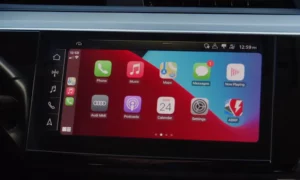Experiencing a tire pressure system malfunction in your Audi can be concerning. As a vital safety feature, it’s crucial to understand the underlying causes of such issues. This article delves into the common reasons for an Audi tire pressure system malfunction and offers valuable insights to help you address them.
By learning about these malfunctions, you can better maintain your Audi’s tire pressure system, ensuring your safety and the vehicle’s performance. Let’s get started on understanding and resolving the issues that might arise with your Audi’s tire pressure system.
Audi Tire Pressure System Overview
Tire Pressure Monitoring System (TPMS)
Audi’s Tire Pressure Monitoring System (TPMS) is an advanced feature that ensures your vehicle’s tires maintain the correct air pressure. This system constantly monitors the air pressure in each tire and alerts you when the pressure is too low, which can be dangerous and reduce fuel efficiency.
In an Audi, a yellow warning light will appear on the dashboard if there’s a significant drop in tire pressure or a TPMS malfunction. Common causes for a system malfunction can include a damaged wheel speed sensor wire, sensor battery failure, or changes in tire size and pressure specifications.
Importance of Proper Tire Pressure
Maintaining the correct tire pressure in your Audi is crucial for several reasons:
- Safety: Underinflated tires can lead to poor vehicle handling, longer braking distances, and an increased risk of tire blowouts.
- Fuel Efficiency: Proper tire pressure ensures optimal fuel consumption since underinflated tires create more rolling resistance, causing the engine to work harder.
- Tire wear: Incorrect tire pressure can lead to uneven and faster wear, making tires need replacement sooner.
To avoid these issues, it’s essential to regularly check and adjust your tire pressure according to Audi’s recommendations, which can usually be found on a sticker inside your door jamb or in the vehicle’s manual.
Remember, following the guidelines for your Audi’s tire pressure will not only prolong the life of your tires but also enhance your driving experience and overall safety. Always address any TPMS warnings or malfunctions promptly to ensure the best performance from your Audi vehicle.
Common Causes of Audi TPMS Malfunction
Faulty Tire Pressure Sensor
One of the main reasons for a TPMS malfunction in your Audi is a faulty tire pressure sensor. These sensors are located in the tires and are responsible for monitoring the air pressure within each tire. If the sensor becomes damaged, inaccurate, or fails completely, it can cause the TPMS warning light to illuminate on your dashboard. To resolve this issue, you may need to have the faulty sensor replaced by a qualified mechanic.
Dead Sensor Batteries
Another common cause of TPMS malfunction is dead sensor batteries. Each tire pressure sensor is equipped with a battery, which powers the sensor to send signals about the tire pressure to your car’s computer. Over time, these batteries can run out of power and cause the sensor to stop functioning properly. This, in turn, leads to a TPMS warning on your dashboard. To fix this issue, you’ll need to replace the sensor batteries or, in some cases, the entire sensor. It’s important to consult with a qualified mechanic for assistance with this task.
Damaged Valve Stems
Damaged valve stems can also cause your Audi’s TPMS to malfunction. The valve stem is the part of your tire that you use to inflate or deflate the tire. If it becomes damaged or corroded, it can lead to inaccurate readings from your tire pressure monitoring system, resulting in a TPMS warning light. To fix this issue, you’ll need to inspect the valve stems for damage or corrosion and replace them if necessary. Proper maintenance of your tires, such as regularly checking and adjusting tire pressure with a reliable tire gauge, can help prevent valve stem damage and TPMS issues.
In conclusion, your Audi’s TPMS may malfunction due to faulty tire pressure sensors, dead sensor batteries, or damaged valve stems. By addressing these issues and maintaining proper tire pressure, you can help ensure that your TPMS stays in good working condition and continues to provide accurate readings for your safety on the road.
How to Diagnose and Reset Audi TPMS Malfunction
Dashboard Warning Lights and MMI Display
When your Audi’s tire pressure monitoring system (TPMS) is malfunctioning, you might notice warning lights on the dashboard and messages on the MMI display. Familiarize yourself with some common warning lights such as the low tire pressure symbol and the TPMS malfunction light. This will help you determine whether the issue is related to low tire pressure or system malfunction.
Using Tire Pressure Gauge
Before addressing the TPMS malfunction, ensure that your tires are properly inflated. You can do this by checking each tire’s pressure using a tire pressure gauge. Compare the measurements to the recommended tire pressures found in your owner’s manual or on the driver’s side door panel. If necessary, inflate or deflate your tires to match the recommended values, and retest the pressure with your gauge to confirm.
Vehicle Reset Button
To reset the TPMS malfunction, locate the reset button in your Audi. The specific location might vary depending on your model, but it’s usually found near the driver’s seat, often in the glove box or on the center console. Follow these steps:
- Turn off the engine and make sure the ignition switch is in the “ON” position.
- Press and hold the TPMS reset button until the dashboard or the MMI display indicates that the system is resetting.
- After the reset, if the dashboard warning lights and MMI display messages do not disappear, it may be necessary to visit a professional mechanic or your Audi dealer for further investigation and proper diagnosis.
Remember to always consult your owner’s manual for specific instructions regarding your Audi’s TPMS reset process and to regularly check your tire pressures at a gas station or using a tire gauge at home. Properly inflated tires not only help maintain the performance and safety of your vehicle but also contribute to fuel efficiency and overall driving comfort.
Maintenance and Prevention Tips
Regular Tire Pressure Checks
To maintain your Audi’s tire pressure monitoring system (TPMS) and prevent malfunctions, it’s essential to regularly check your tire pressure. When the TPMS warning light appears, it’s important to address the issue promptly. You should also make it a habit to inspect your tire pressure at least once a month, even if the warning light doesn’t come on.
To check your tire pressure, use a reliable tire pressure gauge. Carefully remove the valve cap from one of your tires, attach the gauge, and note the reading. Repeat this process for all four tires. Compare these readings to the recommended tire pressures listed in your owner’s manual or on the sticker located inside the driver’s side door. If the pressure is off by 25% or more, your TPMS warning light may activate. Adjust the tire pressure, as necessary, to keep your TPMS functioning properly.
Replacing Worn or Damaged Sensors
In some cases, TPMS malfunctions may be caused by worn or damaged sensors. Your Audi’s tire pressure monitoring sensors can become damaged from regular wear and tear, road debris, or even changing tires. To maintain an accurate and functional TPMS, it is crucial to inspect your sensors when you rotate your tires or replace them, and replace any damaged sensors.
Consulting the Owner’s Manual
Lastly, always refer to your Audi owner’s manual for specific information on maintaining your TPMS. Your manual will provide essential guidelines for tire pressure monitoring system maintenance, as well as recommended tire pressures for your specific Audi model. Following these guidelines can help prevent TPMS malfunctions and ensure that your tire pressure system remains accurate and reliable.










